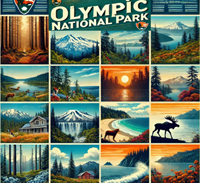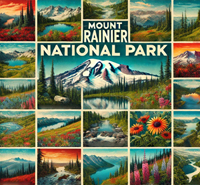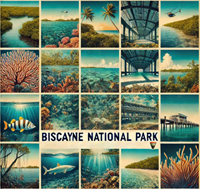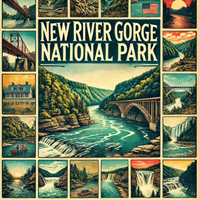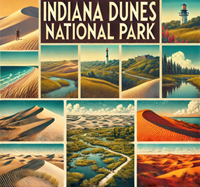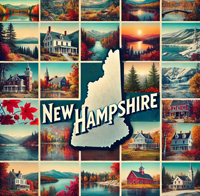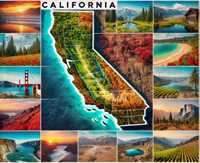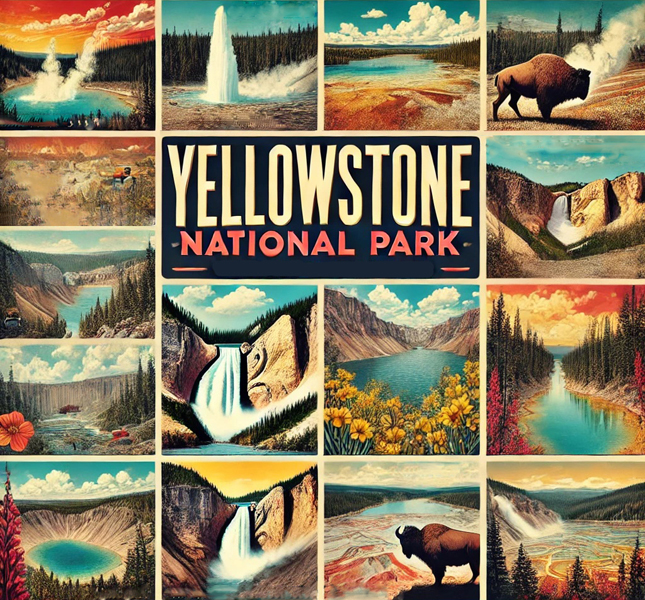

Embark on a journey curated by seasoned explorers William and Hui Cha Stanek, who have spent decades immersing themselves in the diverse landscapes of North America. These itineraries are more than just travel plans - they are thoughtfully crafted adventures designed to help you connect with the natural world, discover hidden gems, and create lasting memories.
National Parks Index | US Itineraries Index | American Roadtrips Index

Bring home a Bugville Critters book and watch as your child's love for reading and learning grows with every page. Hand-painted illustrations bring the heartwarming stories to life. Ask your librarian to add Bugville Critters to the library's digital collection today!
Discover William Stanek's Exclusive Art Collection
Explore and purchase the stunning art featured on this site. Own a piece of William Stanek's unique and captivating artwork today!
(May 2, 2025) Exploring Yellowstone and Grand Teton: Wyoming's Majestic Wilderness
Introduction: A 2-Day Journey into the Heart of Wyoming's Wilderness
There's a certain magic to the wild places of Wyoming. It's a land where the earth still speaks in the language of fire and ice, where towering peaks rise against the sky and where geysers erupt with ancient fury. For Hui Cha and me, Yellowstone National Park and Grand Teton National Park represent the pinnacle of nature's raw power and beauty. These parks are not just destinations – they are experiences that reconnect you with the primal forces that shape our world.
Our journey began on a cool summer morning as we made our way north from Jackson, Wyoming. The Tetons rose dramatically to our left, their jagged peaks catching the first light of day. It's a sight that never fails to take your breath away, no matter how many times you see it. But our adventure wouldn't truly begin until we reached Yellowstone, a place where the earth's crust is thin and the wonders beneath the surface break through in a spectacular display.
Yellowstone is a park like no other. It's a place where geysers, hot springs, and mud pots bubble and steam, where waterfalls cascade over ancient cliffs, and where the wildlife roams free as it has for thousands of years. The moment we entered the park, we were greeted by the unmistakable scent of sulfur, a reminder that we were standing on one of the largest active volcanic systems in the world. Every visit to Yellowstone feels like stepping into a different world, one where the rules of nature are written in fire and stone.
But no trip to this region is complete without also exploring Grand Teton National Park. Where Yellowstone is untamed and wild, the Tetons offer a sense of peace and tranquility. The towering peaks of the Teton Range, mirrored in the still waters of alpine lakes, create a landscape of unparalleled beauty. Here, nature's grandeur is on full display, from the majesty of the mountains to the quiet beauty of the meadows and forests.
Join us as we take you on a journey through these two remarkable parks – Yellowstone and Grand Teton. We'll share our stories, tips, and insights to help you create your own unforgettable experiences in Wyoming's majestic wilderness.
Day 1: The Wonders of Yellowstone National Park
Morning: Sunrise at Lamar Valley
Overview
Start your Yellowstone adventure with a sunrise in Lamar Valley, often called "America's Serengeti" for its abundant wildlife. As the morning light breaks over the valley, you'll have a chance to see bison, elk, and maybe even wolves or bears in their natural habitat.
Tips from William
"Arrive at Lamar Valley by 5:30 AM to catch the first light of the day. The early morning hours are the best time to spot wildlife, so bring a telephoto lens to capture distant animals. A wide-angle lens is also useful for capturing the vastness of the valley as the sun rises behind the mountains."
Insights from Hui Cha
"Lamar Valley in the early morning is a place of quiet beauty. The mist rising from the rivers, the sound of bison moving through the grass, and the sight of the sun slowly illuminating the valley make it a perfect place to start your day. Dress warmly, as it can be quite chilly before the sun fully rises."
How to Access Lamar Valley
Directions:
- From the Northeast Entrance of Yellowstone, follow the Northeast Entrance Road for about 10 miles to reach Lamar Valley.
Viewing Areas:
- Location: Various pullouts along the road offer excellent views of the valley.
- Elevation Gain: Minimal
- Difficulty: Easy
Photography Tips: Position yourself at one of the pullouts that overlook the valley for the best views. Use a telephoto lens to zoom in on wildlife, and switch to a wide-angle lens to capture the sweeping landscapes. If you're lucky, you might even catch the morning mist rolling through the valley, creating a truly magical scene.
Alternative Activity: If you prefer a less early start, consider visiting Hayden Valley later in the morning. While it's busier, Hayden Valley offers similar wildlife viewing opportunities and stunning landscapes.
Mid-Morning: Exploring the Grand Canyon of the Yellowstone
Overview
After the serenity of Lamar Valley, make your way to the Grand Canyon of the Yellowstone, one of the park's most dramatic features. The canyon is home to the famous Lower Falls, which plunges over 300 feet into the Yellowstone River below.
Tips from William
"The Grand Canyon of the Yellowstone is a must-see, and the best views are from the various overlooks along the North and South Rims. Bring a wide-angle lens to capture the full scope of the canyon, and a neutral density filter to smooth out the water if you're photographing the falls. Plan to spend a couple of hours exploring both rims for different perspectives."
Insights from Hui Cha
"There's something awe-inspiring about standing at the edge of this canyon and listening to the roar of the falls. The colors of the canyon walls, the power of the river, and the sheer drop to the bottom are breathtaking. I love taking my time at each overlook, just soaking in the beauty of this natural wonder."
How to Access the Grand Canyon of the Yellowstone
Directions:
- From Lamar Valley, head south on Grand Loop Road for approximately 40 miles to Canyon Village, then follow signs to the North and South Rim Drives.
Overlook Highlights:
- Artist Point: Offers one of the most iconic views of the Lower Falls.
- Lookout Point: Provides a closer view of the falls and a dramatic perspective of the canyon.
- Inspiration Point: Located on the North Rim, this overlook offers sweeping views of the canyon.
Photography Tips: For the best shots of the Lower Falls, arrive at Artist Point in the mid-morning when the sun is behind you, illuminating the falls and the canyon. Use a tripod and a slow shutter speed to capture the movement of the water. The vibrant colors of the canyon walls are best captured with a polarizing filter to enhance contrast and reduce glare.
Afternoon: Geyser Gazing at Old Faithful and the Upper Geyser Basin
Overview
In the afternoon, head to the Upper Geyser Basin, home to the world-famous Old Faithful geyser and the largest concentration of geysers in the park. This area is a geothermal wonderland, with steaming vents, bubbling pools, and geysers that erupt with surprising regularity.
Tips from William
"Plan to arrive at the Upper Geyser Basin in time to catch an eruption of Old Faithful. The eruptions are predictable, occurring roughly every 90 minutes, so check the schedule at the visitor center. A telephoto lens is great for capturing the geyser's eruption, but don't forget to explore the rest of the basin, which offers a variety of geothermal features to photograph."
Insights from Hui Cha
"Watching Old Faithful erupt is a classic Yellowstone experience, but I find that the quieter spots in the Upper Geyser Basin are just as fascinating. The colors of the hot springs, the intricate patterns of the sinter terraces, and the sheer variety of geothermal features make this area a joy to explore."
How to Access Old Faithful and the Upper Geyser Basin
Directions:
- From the Grand Canyon of the Yellowstone, follow Grand Loop Road south for about 30 miles to the Old Faithful area.
Geyser Highlights:
- Old Faithful: The most famous geyser in the world, with eruptions every 60 to 90 minutes.
- Castle Geyser: Known for its powerful eruptions and distinctive cone.
- Grand Geyser: The tallest predictable geyser in the world, with eruptions reaching up to 200 feet.
Photography Tips: For the best shots of Old Faithful, position yourself on the boardwalk with the geyser centered in your frame. Use a fast shutter speed to freeze the action, or a slower shutter speed to capture the movement of the steam. After the eruption, explore the other geysers and hot springs in the basin – each one offers a unique photographic opportunity.
Alternative Activity: If the crowds at Old Faithful are too much, consider exploring the nearby Black Sand Basin or Biscuit Basin. These areas are less crowded and offer beautiful geothermal features, including colorful hot springs and small geysers.
Evening: Sunset at Yellowstone Lake
Overview
End your day with a visit to Yellowstone Lake, the largest high-elevation lake in North America. The lake's serene waters reflect the surrounding mountains, creating a tranquil scene that's perfect for watching the sunset.
Tips from William
"Yellowstone Lake is a beautiful spot to capture the sunset, especially with the Absaroka Range in the distance. Bring a tripod to stabilize your camera for long exposures, and use a wide-angle lens to capture the full scene. The light changes quickly at this time of day, so be ready to adjust your settings as the sun dips below the horizon."
Insights from Hui Cha
"Sunset at Yellowstone Lake is one of my favorite experiences in the park. The colors of the sky reflected in the water, the sound of the waves gently lapping against the shore, and the peacefulness of the moment make it a perfect way to end the day. Bring a blanket and a warm drink, and take some time to simply sit and enjoy the view."
How to Access Yellowstone Lake
Directions:
- From the Upper Geyser Basin, follow Grand Loop Road east for about 20 miles to reach Yellowstone Lake.
Viewing Areas:
- Lake Butte Overlook: Offers panoramic views of the lake and the surrounding mountains.
- Fishing Bridge: A popular spot for watching the sunset over the lake.
Photography Tips: For a stunning sunset shot, set up your tripod near the shore of the lake and capture the reflection of the mountains in the water. Use a small aperture (f/16 or smaller) to keep the entire scene in focus, and experiment with different shutter speeds to capture the changing light. If the conditions are right, consider staying after sunset to photograph the stars as they appear.
Alternative Activity: If you prefer a quieter spot for sunset, consider visiting West Thumb Geyser Basin, located on the western shore of Yellowstone Lake. This area offers beautiful views of the lake and unique geothermal features, including colorful hot springs and bubbling mud pots.
Conclusion: Reflections on the Day
As the last rays of sunlight faded from the sky and the stars began to emerge, Hui Cha and I stood quietly by the shore of Yellowstone Lake, reflecting on the incredible journey we had just experienced. From the wildlife-filled valleys to the dramatic canyons and geothermal wonders, each moment had been a reminder of the power and beauty of Yellowstone.
These are the kinds of experiences that stay with you long after the trip is over – the quiet moments of reflection, the awe-inspiring views, and the sense of peace that comes from being immersed in nature. As we packed up our gear and prepared to head back to our campsite, I felt a deep sense of gratitude for the day's adventures and for the time spent in this remarkable park.
Our journey through Wyoming's majestic wilderness was far from over. Tomorrow would take us to Grand Teton National Park, where we would explore a landscape of towering peaks, alpine lakes, and peaceful meadows. But for now, we were content to sit beneath the stars, listening to the gentle lapping of the water and feeling the peace that only comes from being in the heart of the wilderness.
Day 2: The Tranquil Beauty of Grand Teton National Park
Morning: Sunrise at Schwabacher Landing
Overview
Begin your day in Grand Teton National Park with a sunrise at Schwabacher Landing, one of the most picturesque spots in the park. This quiet area along the Snake River offers stunning views of the Teton Range reflected in the still waters, making it a favorite among photographers.
Tips from William
"Arrive at Schwabacher Landing by 5:30 AM to catch the first light of the day. The calm water creates a perfect mirror for the Tetons, so bring a wide-angle lens to capture the full scene. A polarizing filter will help enhance the colors and reduce glare, especially as the sun rises higher in the sky."
Insights from Hui Cha
"There's a peacefulness to Schwabacher Landing that I absolutely love. The way the mountains are reflected in the water, the sound of the river flowing gently by, and the sight of wildlife coming to the water's edge make this a perfect place to start the day. Dress warmly, as it can be chilly before the sun fully rises."
How to Access Schwabacher Landing
Directions:
- From Jackson, take US-191 north for about 15 miles, then turn left onto Schwabacher Road and follow it to the parking area.
Viewing Areas:
- Location: Along the Snake River, accessible by a short walk from the parking area.
- Elevation Gain: Minimal
- Difficulty: Easy
Photography Tips: Position yourself along the riverbank to capture the reflection of the Tetons in the water. Use a small aperture (f/16 or smaller) to keep both the mountains and the reflection in focus. If you're lucky, you might even catch some wildlife in the scene, adding an extra element to your composition.
Alternative Activity: If you prefer a more accessible sunrise location, consider visiting Mormon Row, where the historic barns provide a striking foreground to the Teton Range. This area is also popular with photographers and offers beautiful views of the mountains at sunrise.
Mid-Morning: Hiking to Taggart Lake
Overview
After watching the sunrise, continue your morning with a hike to Taggart Lake, a beautiful alpine lake nestled at the base of the Teton Range. This trail offers stunning views of the mountains and a peaceful setting to enjoy the natural beauty of the park.
Tips from William
"The hike to Taggart Lake is 3 miles round-trip with a moderate elevation gain of 300 feet. Start early to avoid the crowds and bring plenty of water. A wide-angle lens is essential for capturing the expansive views of the lake and surrounding peaks, and a polarizing filter will help enhance the colors of the water and sky."
Insights from Hui Cha
"This hike is one of my favorites in Grand Teton National Park. The scenery is absolutely breathtaking, with the trail winding through meadows and forests before reaching the lake. Take your time and enjoy the journey – the destination is just as rewarding as the hike itself."
How to Access Taggart Lake
Directions:
- The trailhead is located at the Taggart Lake Trailhead, about 3 miles north of the Moose Entrance Station on Teton Park Road.
Trail Details:
- Trail Length: 3 miles round-trip
- Elevation Gain: 300 feet
- Difficulty: Moderate
Photography Tips: For the best shots of Taggart Lake, arrive early to catch the morning light as it reflects off the water. Use a wide-angle lens to capture the full scene, and a polarizing filter to enhance the colors and reduce glare. If you're visiting in the summer, take advantage of the wildflowers along the trail – use a macro lens to capture their intricate details.
Alternative Activity: If the hike to Taggart Lake is too challenging, consider exploring the shorter String Lake Trail, which is a 1.2-mile loop with minimal elevation gain. String Lake is smaller but equally beautiful, with stunning views of the surrounding peaks.
Afternoon: Exploring the Jenny Lake Loop
Overview
In the afternoon, head to Jenny Lake, one of the most popular spots in the park. The Jenny Lake Loop is a scenic drive that offers breathtaking views of the lake and the surrounding mountains, as well as access to several trailheads for those looking to explore on foot.
Tips from William
"Jenny Lake is a photographer's paradise, with its crystal-clear waters and the towering Tetons in the background. Bring a wide-angle lens to capture the expansive views, but also keep a telephoto lens handy for zooming in on the details of the peaks and the reflections in the water. Plan to spend a few hours exploring the area – there's so much to see and photograph."
Insights from Hui Cha
"This area is one of the most beautiful in the park, and there are so many ways to experience it. Whether you're hiking along the lake, taking a boat ride to the base of the mountains, or simply sitting by the shore, the beauty of Jenny Lake is truly something special. I love finding a quiet spot along the trail to just sit and take it all in."
How to Access the Jenny Lake Loop
Directions:
- From the Taggart Lake Trailhead, head north on Teton Park Road for about 6 miles to reach the Jenny Lake area.
Route Details:
- Total Distance: 8 miles (loop)
- Elevation Gain: Minimal (depending on the trail)
- Difficulty: Easy to Moderate (depending on the trail)
Photography Tips: Stop at various points along the loop to capture different perspectives of the lake and mountains. Use a wide-angle lens to capture the expansive views, and switch to a telephoto lens to zoom in on the details of the peaks and the reflections in the water. For a more creative shot, try framing the lake with the trees and wildflowers that line the shore.
Alternative Activity: If you prefer a more immersive experience, consider hiking the Jenny Lake Trail, an 8-mile loop that offers stunning views of the lake and the surrounding mountains. The trail is relatively flat and easy, making it a great option for those looking to explore the area on foot.
Evening: Sunset at Oxbow Bend
Overview
End your day with a visit to Oxbow Bend, one of the most photographed spots in Grand Teton National Park. The Snake River meanders through the valley, reflecting the towering peaks of the Teton Range, creating a scene that's perfect for watching the sunset.
Tips from William
"Oxbow Bend is a must-visit spot for any photographer, especially at sunset. The calm water creates a perfect mirror for the mountains, so bring a wide-angle lens to capture the full scene. A tripod is essential for stabilizing your camera for long exposures, and a polarizing filter will help enhance the colors and reduce glare."
Insights from Hui Cha
"Sunset at Oxbow Bend is one of the most beautiful experiences you can have in Grand Teton National Park. The way the light plays across the water, the reflections of the mountains, and the peacefulness of the moment make it a perfect way to end the day. Bring a blanket and a warm drink, and take some time to simply sit and enjoy the view."
How to Access Oxbow Bend
Directions:
- From Jenny Lake, head north on Teton Park Road for about 13 miles, then turn right onto US-191 and follow signs to Oxbow Bend.
Viewing Areas:
- Location: Along the Snake River, accessible by a short walk from the parking area.
- Elevation Gain: Minimal
- Difficulty: Easy
Photography Tips: For a stunning sunset shot, set up your tripod near the shore of the river and capture the reflection of the Tetons in the water. Use a small aperture (f/16 or smaller) to keep the entire scene in focus, and experiment with different shutter speeds to capture the changing light. If the conditions are right, consider staying after sunset to photograph the stars as they appear.
Alternative Activity: If you prefer a quieter spot for sunset, consider visiting Jackson Lake Dam, located just a few miles to the north. The views of the Teton Range reflected in the lake are equally stunning, and the area is less crowded than Oxbow Bend.
Conclusion: A Personal Reflection
As the last rays of sunlight faded from the sky and the stars began to emerge, Hui Cha and I stood quietly at Oxbow Bend, reflecting on the incredible journey we had just experienced. From the dramatic geysers of Yellowstone to the tranquil beauty of the Tetons, each moment had been a reminder of the power and majesty of Wyoming's wilderness.
These parks are more than just places to visit – they are places to connect with the natural world, to find peace and inspiration, and to create memories that will last a lifetime. As we packed up our gear and prepared to leave, I felt a deep sense of gratitude for the time we had spent in these wild, untamed places. They had not only shown us the beauty of the land but had also brought us closer to each other and to the world around us.
Our journey through Wyoming's majestic wilderness had come to an end, but the experiences we had shared would stay with us forever. And as we drove away from the mountains, I knew that we would return, drawn back by the promise of new adventures and the chance to explore even deeper into the heart of the Rockies.

Step into a world of timeless beauty with our premium, oversized hardcover book - crafted for discerning collectors and anyone who values the power of art. Perfect for your coffee table, it's more than just a book; it's a conversation starter, a window into over 30 years of William's visionary photography.
Your Support Matters
Purchasing artwork from William Stanek's collection not only brings beauty into your life but also helps us continue to share. Thank you for supporting our creative journey!

Support The Lights of Paris by Robert Stanek, William Stanek's pen name! Through vivid historical detail and deeply moving character stories, Robert takes readers on an unforgettable journey through one of history’s most transformative times.


